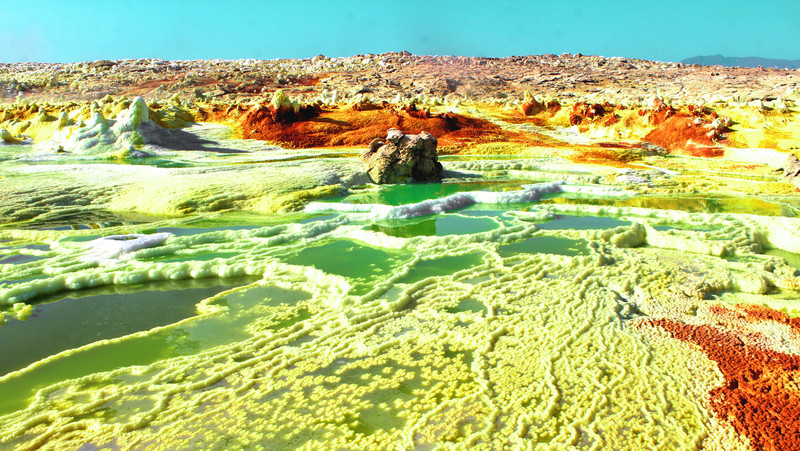Dallol Hydrothermal Field Facts
- This breathtaking formation, with its otherworldly vistas, bears the descriptive and informative name of the Dallol Hydrothermal Field. The system forms a truly unique creation of natural forces. No other site exactly like it appears anywhere else on earth.
- It remains unknown how long ago local inhabitants of its region discovered it. European settlers, however, first stumbled upon it during their colonizing expeditions. Though no official record exists, this likely occurred in the 17th or 18th century.
- The very nature of both the site itself and that of the surrounding region precluded extensive exploration at that time, though. Even today, scientific study of the unique creation of Nature, while ongoing, constitutes a complicated and hazardous procedure.
- Its name derives for the language of the Afar people. They comprise the local Indigenous Peoples of the surrounding region. Applied by that group long ago, in their ancient native language the term effectively translates as disintegration or dissolution.
- Not surprisingly, despite its visual splendor, the Dallol Hydrothermal Field does not represent a tourist draw. That provides it with a measure of protection. The wonder of geology nonetheless remains well known for its eerily captivating color patterns.
Related Articles
Dallol Hydrothermal Field Physical Description
The astounding Dallol Hydrothermal Field immediately entrances those who encounter it with its unearthly sights. Despite its many physical marvels, though, its sheer physical size isn’t among them. That’s because Nature packs all its marvels into a small area.
Its outer perimeter understandably possesses an extremely irregular boundary. In terms of pure area, though, it measures slightly less than 0.4 sq mi (1 sq km). The seemingly preternatural aspects of the world renowned site make it seem far more extensive, however.
These natural marvels also formed around a central feature. That’s the Dallol volcano itself. This feature boasts a relatively broad shape, averaging around 1 mi (1.6 km) in width. In terms of height, it’s quite shallow. In fact, it only measures 164 ft (50 m) in this regard.
The volcanic mountain in the midst of the Dallol Hydrothermal Field garners its own fair share of appreciation. It’s believed that a circular depression near its center represents a collapsed crater. The banks of the mount hold small pillars and fumaroles.
It’s the area surrounding the volcano that hosts its amazing features, though. These include such fabulous sorts as numerous hot springs, brine pools, multicolored sand deposits, miniature geysers, and even pools of acid! It’s truly like stepping onto another world entirely.
Dallol Hydrothermal Field Location, Formation, and Geology
The spellbinding Dallol Hydrothermal Field formed in a region of the globe already well known for its natural marvels. In fact, another equally impressive, albeit in a different manner, natural feature, Erta Ale, lies not far to the northeast of this impressive formation.
That’s due to the fact that, like the other aforementioned wonder, it formed on the continent of Africa. Its geographic location places it within the borders of the country of Ethiopia. The remarkable site further resides in the vast region now known as the Danakil Depression.
Evidence indicates that this marvel formed sometime during what geologists know as the Miocene epoch. This places its origins sometime between approximately 23 – 5.3 million years ago. Experts are still unable to determine its date of origin any more precisely.
Its creation originally occurred due to the intrusion of basaltic magma into the salt deposits of the region. The still ongoing hydrothermal activity seems to have begun sometime later. Minor eruptions actually caused the creation of the small volcano recently, in 1926.
The setting crafted by the Dallol Hydrothermal Field is truly unbelievable, unless one sees it for oneself. Many hot springs secrete brine and other acidic compounds continuously. Small, short-lived geysers manifest at random times and places, depositing cones of salt.
It’s doubtless the vibrant colors of the various deposits that garner the most attention, though. Several impurities, including iron, generate the bright brown, ochre, and yellow shades. Oxidation of older deposits often create the darker brown patches present.
Features Sharing Its Region
Check out our other articles on Kangaroo Island, Old Faithful, Stromboli, Bisti De-Na-Zin Wilderness, Bloody Hell Pond, Ring-Tailed Cat, Queen of the Andes, Inaccessible Island Rail

